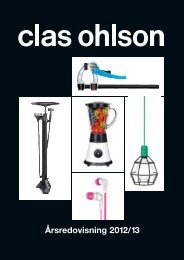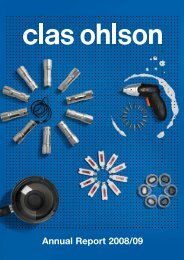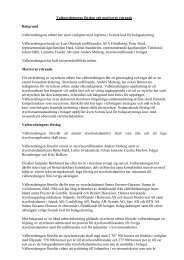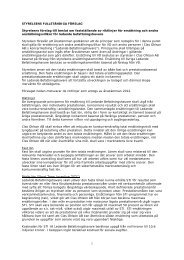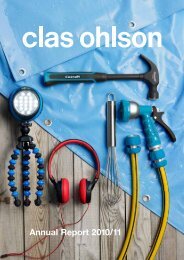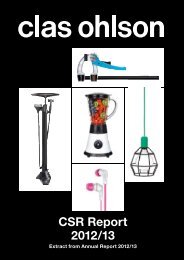Annual Report 2012/13 - Clas Ohlson
Annual Report 2012/13 - Clas Ohlson
Annual Report 2012/13 - Clas Ohlson
You also want an ePaper? Increase the reach of your titles
YUMPU automatically turns print PDFs into web optimized ePapers that Google loves.
<strong>Clas</strong> <strong>Ohlson</strong>’s catalogues are printed according to Nordic<br />
Ecolabel criteria, and mainly distributed in conjunction with<br />
goods deliveries to our stores. Our direct marketing and this<br />
annual report are also printed on Nordic Ecolabel-approved<br />
paper. The <strong>Clas</strong> <strong>Ohlson</strong> <strong>Annual</strong> <strong>Report</strong> is only distributed to<br />
shareholders who request printed information, which has<br />
reduced the number of issues printed by some 70 per cent<br />
and thus lowered our environmental impact.<br />
Legislation and guidelines<br />
<strong>Clas</strong> <strong>Ohlson</strong> is mainly impacted by the following EU<br />
directives:<br />
• Regulations on the use of substances with a toxic impact<br />
on human health and the environment in product<br />
(REACH, RoHS (directive on materials intended to<br />
come into contact with food and the Toy Safety Directive).<br />
• The regulation of energy-related products (ErP).<br />
• Producer responsibility for the recycling of electrical and<br />
electronic equipment (WEEE).<br />
Read more For more information about our environmental<br />
and sustainability efforts, please visit our website<br />
http://about.clasohlson.com.<br />
RoHS: 2002/95/EC on the Restriction of the Use of certain Hazardous<br />
Substances in Electrical and Electronic Equipment.<br />
The RoHS Directive forbids the use of mercury, cadmium, lead, hexavalent<br />
chromium and the flame-retardant substances PBB and PBDE in<br />
new electrical and electronic products released into the market as of 1 July<br />
2006. The quantity limit is 0.1 per cent by weight (0.01 per cent cadmium<br />
by weight) of homogeneous material. RoHS covers the product categories<br />
included in WEEE. In Sweden, the Swedish Chemicals Agency is the regulatory<br />
body.<br />
Reach: 1907/2006/EC Registration, Evaluation, Authorisation and Restriction<br />
of Chemicals.<br />
The Directive came into effect throughout the EU on 1 June 2007 and<br />
REACH regulations will be introduced gradually through 2018. REACH is<br />
based on the principle that it is the party that manufactures or introduces<br />
a chemical into the market who is responsible for determining the risks<br />
associated with the chemical before it is put into use. Chemical manufacturers<br />
and users shall prepare data on the chemicals’ properties and assess<br />
the risks. A new authorisation procedure will be introduced for chemicals<br />
with properties that are seriously hazardous to the environment and health.<br />
Particularly hazardous substances are entered in a so-called candidate list.<br />
All manufacturers, importers or sellers of goods on the candidate list containing<br />
more than 0.1 per cent by weight of a substance must present this<br />
information to their customers to ensure that the product can be handled<br />
safely.<br />
WEEE: 2002/96/EC on Waste Electrical and Electronic Equipment.<br />
The aim is to design and produce electrical and electronic products in a<br />
manner that prevents waste. When waste anyway occurs, it is to be collected<br />
and reused or recycled in an environmentally sound manner. Manufacturers<br />
and importers are to pay for future recycling of products and ensure that<br />
collection and environmentally sound recycling is performed. In Sweden, the<br />
Swedish Environmental Protection Agency is the regulatory body.<br />
<strong>Clas</strong> <strong>Ohlson</strong>'s GRI profile (Global <strong>Report</strong>ing Initiative)<br />
EC1<br />
A complete version is available at http://om.clasohlson.com/en<br />
<strong>Clas</strong> <strong>Ohlson</strong> reports at C level.<br />
Performance indicators<br />
Financial impact<br />
Direct economic value generated and distributed, including revenues, operating costs, employee compensation, donations<br />
and other community investments, retained earnings, and payments to capital providers and governments. 60-63<br />
Environmental impacts<br />
EN3 Direct energy consumption by primary energy source. 41<br />
EN4 Indirect energy consumption by primary energy source. 41<br />
EN16 Total direct and indirect greenhouse gas emissions by weight. 41<br />
EN17 Other relevant indirect greenhouse gas emissions by weight. 41<br />
EN18 Initiatives to reduce greenhouse gas emissions, and reductions achieved. 28, 40, 41, 42<br />
Social impact<br />
LA1 Total workforce by employment type, employment terms and region. 37, 75 note 31<br />
LA2 Employee turnover. 38<br />
LA10 Average number training hours per employee and year per employee category. 37<br />
LA<strong>13</strong><br />
HR2<br />
Composition of governance bodies and breakdown of employees per category according to gender, age group, minority<br />
group membership, and other diversity indicators. 38, 78-83<br />
Human rights<br />
Percentage of significant suppliers and contractors that have undergone screening on human rights, and actions taken.<br />
HR4 Number of cases of discrimination and actions taken. 34<br />
HR5<br />
HR6<br />
HR7<br />
PR1<br />
Operations identified in which the right to exercise freedom of association and collective bargaining may be at significant<br />
risk, and actions taken to support these rights. 34<br />
Operations identified as having significant risk for incidents of child labour, and measures taken to contribute to the elimination<br />
of child labour. 34<br />
Operations identified as having significant risk for incidents of forced or compulsory labour, and measures taken to contribute<br />
to the elimination of forced or compulsory labour. 34<br />
Product responsibility<br />
Lifecycle stages in which health and safety impacts of products and services are assessed for improvement, and percentage<br />
of significant products and services categories subject to such procedures. 41, 42<br />
Page<br />
7, 33<br />
Sustainable development Sustainable development 43




